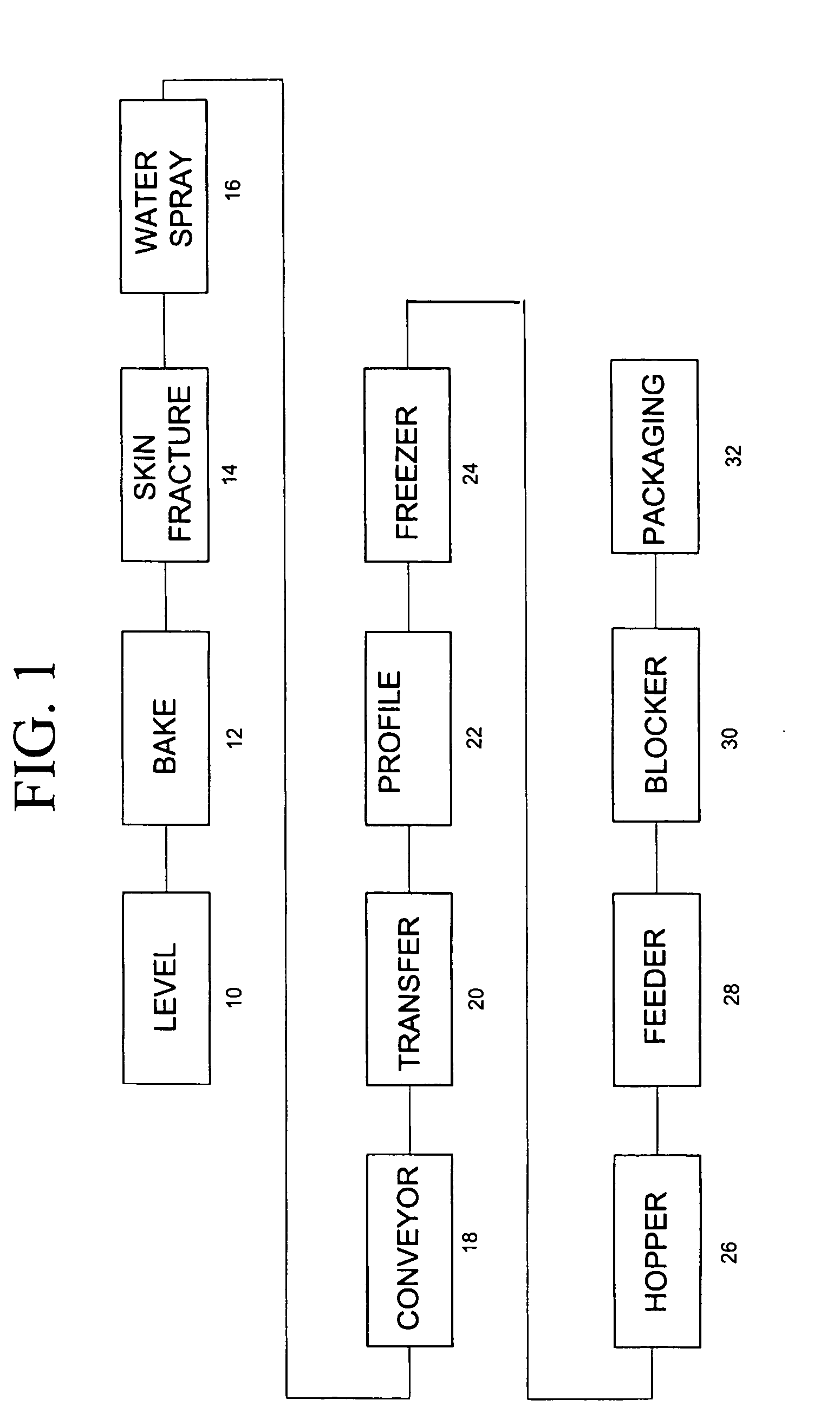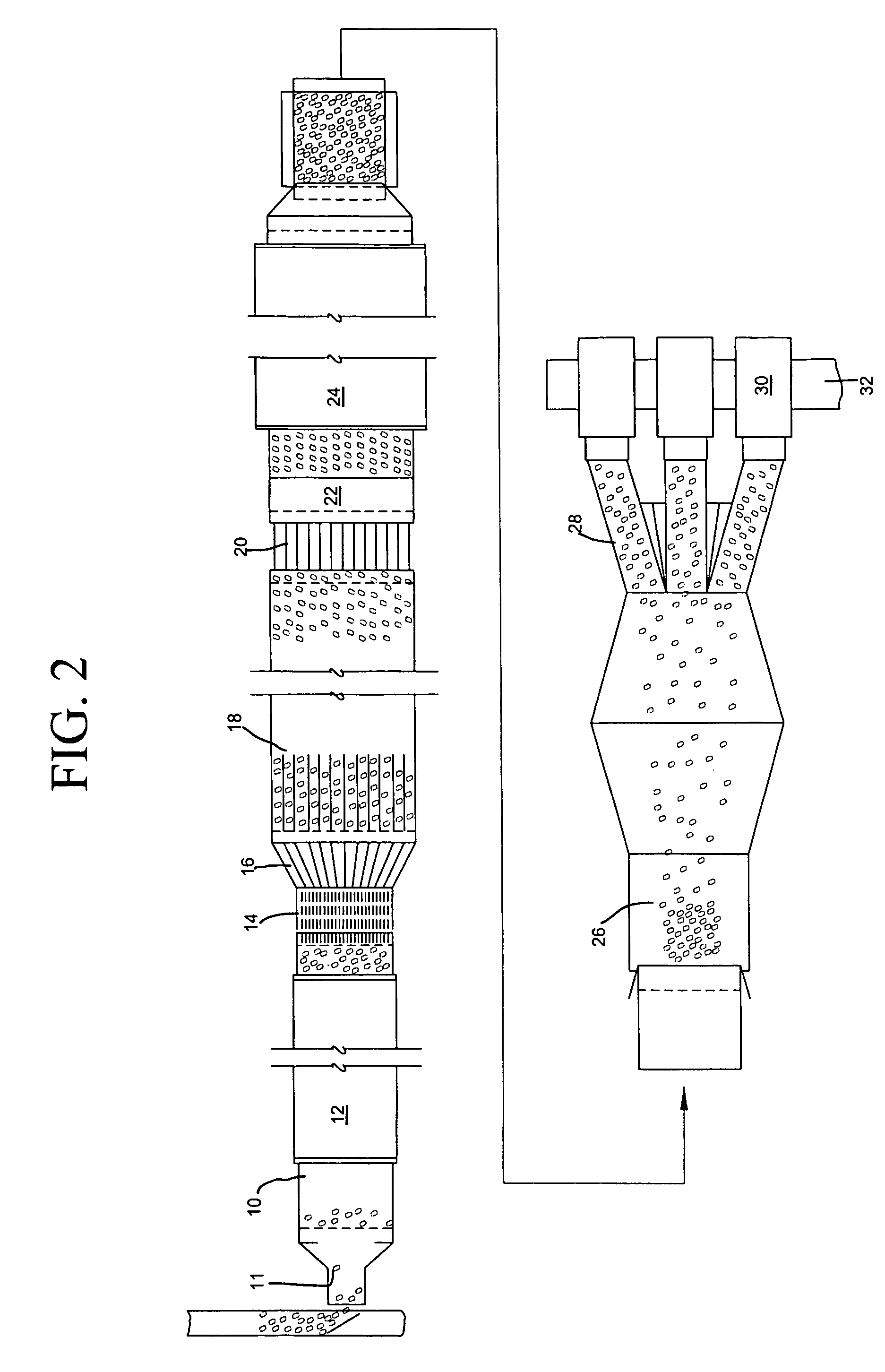Baked potato products and process for preparing same
- Summary
- Abstract
- Description
- Claims
- Application Information
AI Technical Summary
Benefits of technology
Problems solved by technology
Method used
Image
Examples
example 1
[0097]This example illustrates the preparation of potato products according to the invention.
[0098]Russet Norkotah potatoes having an average weight of about 6 ounces were processed according to a process as outlined in FIG. 1. The potatoes were scrubbed and arranged in a level layer on a mesh conveyor. The potatoes were passed through an oven maintained at 420° F. for about 55 minutes, during which they were baked to a moisture content of about 72%. The skins of the baked potatoes were then fractured by a series of rotating blades as shown in FIG. 3, where the skins were fractured around their circumferences. The potatoes were then passed down channels while being sprayed with water for a total hydration time of about 2.25 minutes to increase the moisture content of the potatoes to about 73.5%. The potatoes were then conveyed under a profiling apparatus to flatten the potatoes to a thickness of about ¾ of an inch. The flattened potatoes were then passed through a commercial freezer...
example 2
[0100]This example illustrates the preparation of potato products with a sauce ingredient according to the invention.
[0101]About 18 parts of potato pieces as prepared in Example 1 were simultaneously fed to bags along with 8 parts of frozen chunks (approximately 10×15×40 mm) of sauce mix of the following formulation:
IngredientPartsWater41Cheddar Cheese40Butter15Actoloid 2124, Stabilizer and2emulsifierJoha S9, phosphate salt blend for1emulsificationSodium chloride1Total100
[0102]The resulting mixture of frozen potatoes and sauce is prepared for consumption by heating in a microwave oven.
example 3
[0103]This example reports a textural evaluation of the pulp of potatoes baked according to the invention with control samples to illustrate the textural properties of potato pulp when baked in accord with the invention and compare them to products not optimally processed.
[0104]Objectives:
[0105]To analyze and differentiate the characteristics of internal texture or pulp of potatoes baked to 72.0% moisture considered ideally baked potatoes from raw potatoes, potatoes baked to different moisture levels, and mashed potatoes.
[0106]Samples Analyzed:
[0107]Raw Potatoes
[0108]Potatoes baked to 75.7% moisture
[0109]Potatoes baked to 72.0% moisture
[0110]Potatoes baked to 66.0% moisture
[0111]Mashed Potatoes
[0112]Sample Preparation:
[0113]Raw and Baked Potatoes[0114]Use Russet Norkotah variety from the same grower, field, and lot, weight range between 5.75 and 6.25 oz.[0115]Determine specific gravity and solid using Brine Solution method[0116]Bake potatoes in a forced-air convection oven set at 32...
PUM
 Login to View More
Login to View More Abstract
Description
Claims
Application Information
 Login to View More
Login to View More - R&D
- Intellectual Property
- Life Sciences
- Materials
- Tech Scout
- Unparalleled Data Quality
- Higher Quality Content
- 60% Fewer Hallucinations
Browse by: Latest US Patents, China's latest patents, Technical Efficacy Thesaurus, Application Domain, Technology Topic, Popular Technical Reports.
© 2025 PatSnap. All rights reserved.Legal|Privacy policy|Modern Slavery Act Transparency Statement|Sitemap|About US| Contact US: help@patsnap.com



